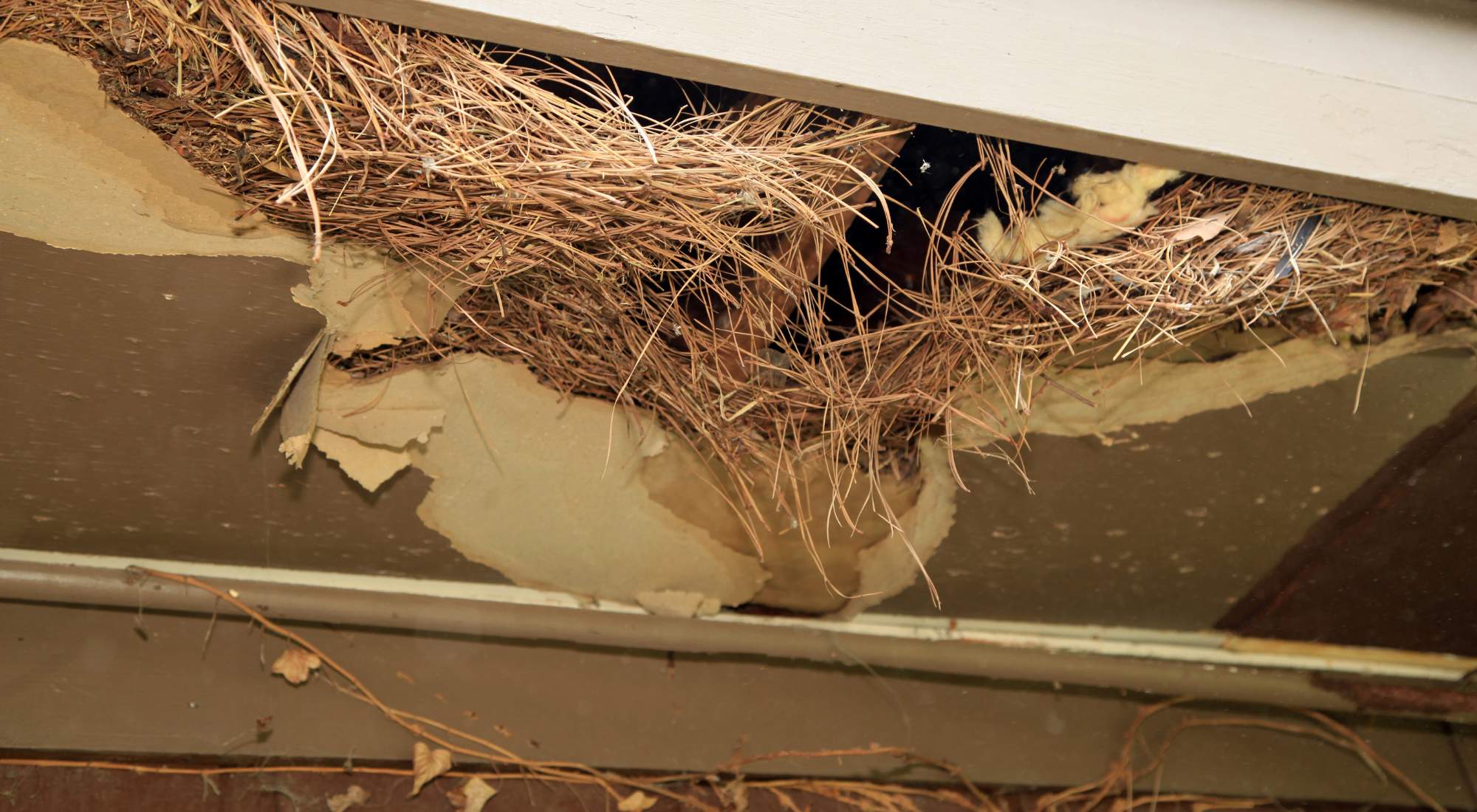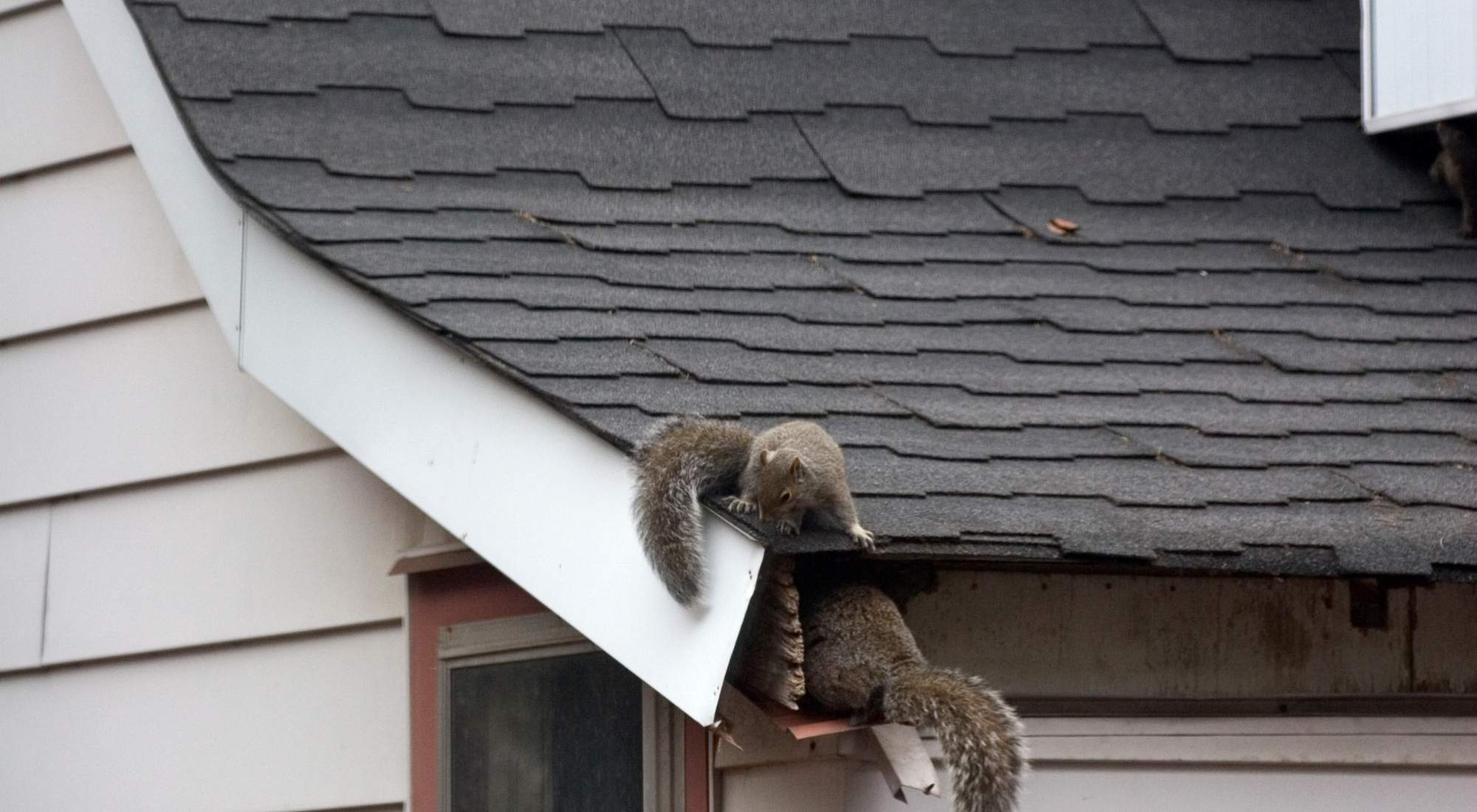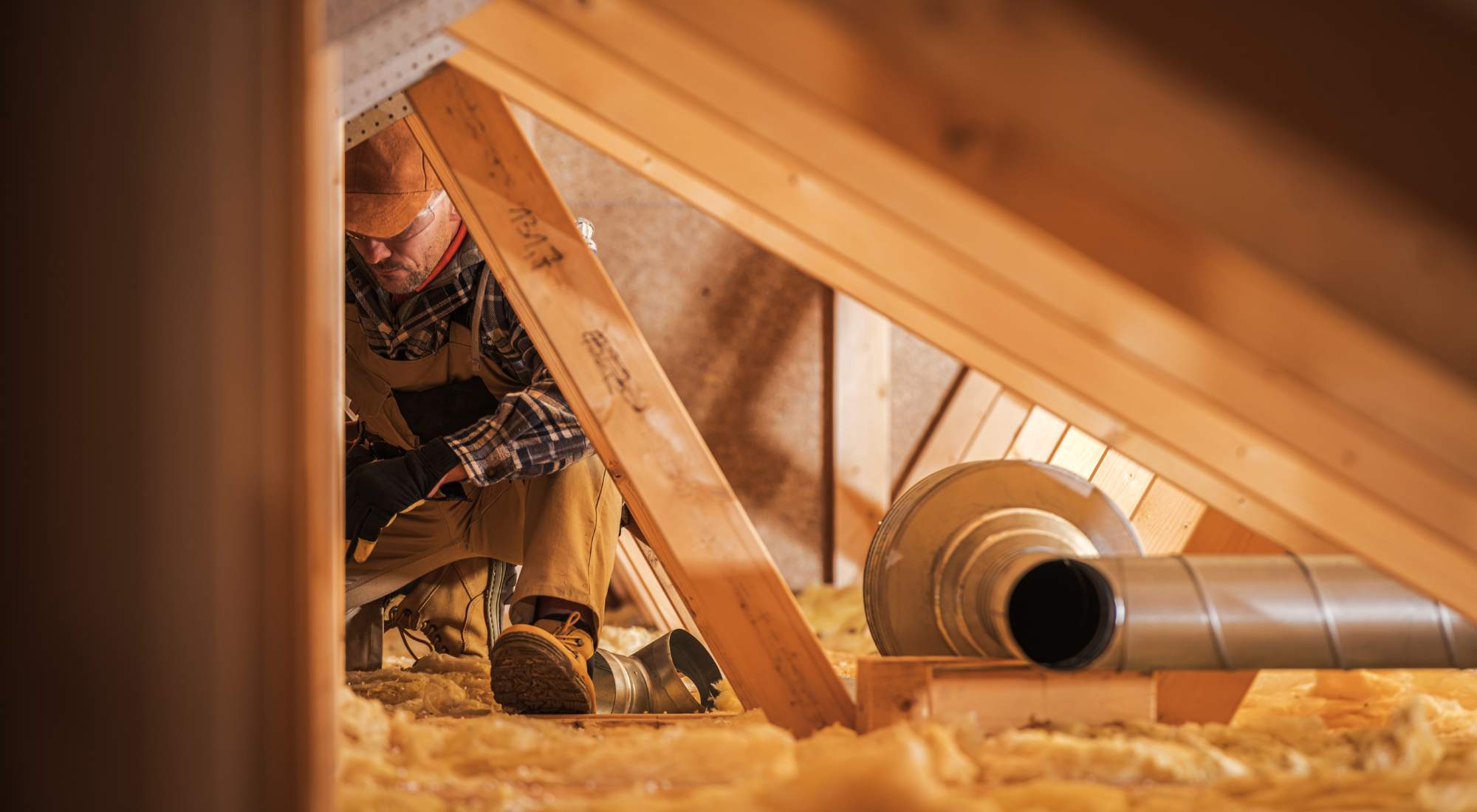The weather is turning colder and it’s time to gather the warmer clothing from the attic. Upon climbing the stairs, you hear the faint chatter of a critter and realize it’s not coming from the outside but somewhere within the eaves.
You’re not alone, and soon discover the unwanted house guests have made themselves right at home. They kindly left a trail of insulation and stuffing from pillows, along with other “evidence” of their presence.
Rodents in your attic can cause damage and leave behind unwanted and dangerous debris. Utilize the following suggestions to learn how to get rid of rodents in the attic and to keep them away in the future.
Table of Contents
- Signs You Have Rodents in the Attic
- How To Get Rid of Rodents in the Attic: 6 Practical Steps
- Trust the Experts at PURE Environmental To Get Your Attic Back in Shape After the Rodents Have Left the Premises

Signs You Have Rodents in the Attic
How do you know if you truly have rodents in your attic?
Signs that rodents are living in the attic may include:
- Droppings
- Rodents leave small, dark pellets that are often found near food or nests.
- Fresh droppings are moist, but will dry out over time.
- Nests
- Rodents will build nests out of anything they can locate such as paper, cloth, or insulation.
- Odor
- Rodents may leave an unpleasant odor, especially close to air vents.
- The odor may indicate the presence of their urine, feces, or dead animals.
- Noise
- Scratching or footsteps may be heard behind walls or in the ceiling of your home, particularly at night.
- Unusual pet behavior
- Your dogs or cats may notice the presence of rodents before you do, as they may hear or smell them more distinctly than humans.
- Chew marks
- Fresh gnaw marks are lighter in color but usually darken with age.
- Rodents may leave gnaw marks on furniture, wood on walls, flooring, or on food packages.
- Oily marks on walls
- If the marks smudge when touching them, they have been recently present.
- Mice or rats will leave oily marks on the walls along their traveled pathways. The marks are from grease found on their fur and frequent surface contact with the walls.
How To Get Rid of Rodents in the Attic: 6 Practical Steps
In order to permanently vacate your unwanted guests, you must not only get rid of present pests but also keep them out for the future.
Additionally, once your home is free of rodents or other pests and you’ve taken preventive measures against further visits, you’ll want to thoroughly clean the attic and repair any internal damage.
The team of professionals at Pure Environmental is equipped to fully clean, decontaminate, and restore your attic space — all with the least possible environmental impact on your attic cleanup.
#1: Identify the Type of Rodent in the Attic
Rodents of all kinds find their way into your cozy attic and have the ability to cause significant damage. Your attic, unfortunately, may be the pests’ idea of an ideal location for safety, protection from the weather, and supplies for their nests.
Squirrels
- How do they get there?
- Squirrels tend to gain access to your home by chewing. They will chew through walls, wires, and wood.
- Squirrels may be heard primarily in the early morning or evening when they are most active.
- Resulting damage from squirrels:
- Torn, shredded, or absence of large pieces of insulation.
- Chewed wood, walls, or wires are the most frequently noted damage.
- Signs and symptoms of their presence:
- Droppings
- Odor or damp spots from urine or feces
- Noises such as scratching, scampering, or chewing
- Nests of squirrels are circular and made from twigs, leaves, grass, and bark — similar to birds’ nests, but larger
Mice
- How do they get there?
- Due to their small size, mice are able to squeeze into tiny spaces.
- Mice are able to climb walls, so they may start at ground level in your home and make their way to the attic without difficulty.
- Resulting damage from mice:
- Structural damage, fire hazards, and short circuits in electrical work are potential damages.
- Mice can contaminate food with their urine, droppings, and hair, which can introduce germs like salmonella.
- They may nibble on food packages and leave partially eaten food behind, making it unsafe for humans and pets to eat.
- Mice are able to carry diseases like hantavirus, fleas or mites, and can be passed on to people through bites or by contaminating dust, food, and water.
- Signs and symptoms of their presence:
- Sounds of scratching, scurrying of feet, or gnawing
- A musty or stale smell
- The presence of their feces, which appear as dark brown/black grains of rice
Rats
- How do they get there?
- Rats prefer warm spaces, so they may seek shelter as the weather becomes cooler.
- Like mice, they are able to squeeze through holes, small spaces, or gaps in walls.
- Resulting damage from rats:
- Significant damage to your home may result from rats chewing walls, baseboards, sheetrock, insulation, and structural elements like beams, doors, and joists.
- Electrical wiring may be compromised if chewed.
- Rats can pose health hazards to humans and pets, as they carry diseases such as leptospirosis and hantavirus.
- Signs and symptoms of their presence:
- Scurrying can be heard throughout the day, as they are active both day and night.
- Nests in high areas. You would find their nests in trees or larger bushes if outdoors, but they may prefer your dry indoor attic during the cold months.
- Rats will gnaw to keep their teeth short. Gnaw marks are often found near droppings or food sources.
- Rats are attracted to odors from pet waste, food, garbage, and even bird feeders. You may notice an unpleasant smell from their presence.
- At dusk or during the night, you can find them traveling along utility lines or fences. They also like stacks of firewood, garbage, or general clutter.

#2: Close Up All Entry Points
Once you have tracked down the entry points the rodents have been using to access your home, they need to be closed and sealed securely. Pay close attention to windows, doors, or screens — they should fit securely in their frames as cracks or small gaps around them will still be sufficient room for rodents to travel.
What products should I use to seal the entry points?
- Caulk or steel wool pads can be utilized to seal small holes.
- Securing larger holes may require products such as concrete, mortar, or sheet metal.
- Avoid utilizing wood or plastic products, as most rodents will not be deterred by this attempt since they can easily chew through these products.
#3: Set Traps
Traps may be set in an attempt to rid your attic of the uninvited house guest, but it is vital to determine first what critter it is to utilize the correct and effective trap.
Depending on your location, it may also be prudent to contact a wildlife trapping company as there may be licensing required to legally trap certain species. The average homeowner may not typically be aware, but wildlife trapping and pest control require different licensing and each company specializes in different types of animals.
There are a variety of traps available for your invading pest:
- Bait traps:
- Lure pests into the unit.
- Sticky traps:
- Lure pests onto the sticky surface and prevent escape.
- Snare traps:
- Often utilized for small rodents.
- Bait and ensnare the rodent preventing escape.
- Catch-and-release live animal traps:
- Animals are humanely secured in a small cage-like trap, and able to be released without harm in another location.
- Manufactured in various sizes suitable for squirrels, raccoons, or other small mammals.
Live traps can be an effective and humane way to capture and release wild animals, but they require careful consideration.
- Benefits:
- Live traps can be more effective than other methods, along with being reusable and cost-effective.
- They’re a good option for homes with children and pets since they do not require chemicals or poisons.
- They will not cause the animal to die and in need of disposal.
- Drawbacks:
- Live traps may cause suffering for the animal and may not be a permanent solution to the problem.
- You will need to transport the animal for relocation and release, and risk injuring the animal in the process.
- The captured animal may not be the only one in your home, which may require capturing and removing each animal separately.
#4: Call a Professional Exterminator
They do not call them pests without reason, and if you’ve made your best efforts for the critters to pack their bags and leave to no avail, it may be time to request backup assistance.
Discussing the need to contact professionals to safely and effectively get rid of rodents in your attic can ensure the health and safety of your family and may be the best choice.
Additionally, for certain pests, plenty of do-it-yourself solutions can effectively dismiss them from your home, but in some cases, the first signs of infestations call for professional help.
Contacting an exterminator as soon as you identify signs of infestations can assist in limiting damage and the number of pests present, and help you confidently clear your home as quickly as possible.

#5: Take Preventative Measures
Preventative measures to avoid further pest infestation can vary from home repairs to changes in habits or even storage of household items.
- Declutter – Keep your home clean and maintain a clutter-free environment.
- Store food properly – Keep food in tightly sealed containers and clean up spills and crumbs promptly.
- Dispose of trash appropriately – Routinely remove trash from your home and store trash in containers with lids.
- Block entry points for pests – Seal cracks in walls and exterior doors, keep doors closed as much as possible, cover vents with wire mesh, cap the chimney, replace broken windows or screens and place vent guards on roof vents.
- Trim trees that are located close to your home.
#6: Hire a Professional for Attic Clean-Up and Decontamination
Following the discovery and removal of pests in your home, you’ll want to be sure your home is appropriately cleaned, restored, and sanitized.
Attics and crawl spaces can be particularly difficult to clean depending on the size, space, damage, and materials such as insulation that was contaminated.
Enlisting the help of the professionals at Pure Environmental will assist you with the following processes:
- Removal of all rodent/pest residuals and damage
- Disposal of deceased pests
- Removal and disposal of contaminated items and materials
- Replacement of damaged insulation if appropriate
- Disinfection
- Sanitization
- Repair and sealing of pest entry or access points into your home
Trust the Experts at PURE Environmental To Get Your Attic Back in Shape After the Rodents Have Left the Premises
Many projects and problems can be effectively addressed by you as the homeowner, but in this case of home damage and contamination from a pest infestation, is this a task that you can appropriately tackle?
Pure Environmental professional services supply quality equipment and technology to complete a healthy, safe, and effective attic cleanup and decontamination.
Trust the team of professionals to restore, repair, and return your home to a healthy environment with their comprehensive services for you and your family.
Recent posts
- Pros and Cons of Heat Treatment for Bed Bugs: Things To Consider When Reviewing Your Options for Remediation
- How To Get Rid of Pet Odor in Your House
- Clearing the Air: How To Clean Walls From Cigarette Smoke
- Deodorizing Your Living Space: How To Get Rid of a Musty Smell in Your House
- How Do You Get Rid of Mold in Your Attic? Tips from the Professionals
Recent Posts
- Pros and Cons of Heat Treatment for Bed Bugs: Things To Consider When Reviewing Your Options for Remediation
- How To Get Rid of Pet Odor in Your House
- Clearing the Air: How To Clean Walls From Cigarette Smoke
- Deodorizing Your Living Space: How To Get Rid of a Musty Smell in Your House
- How Do You Get Rid of Mold in Your Attic? Tips from the Professionals
